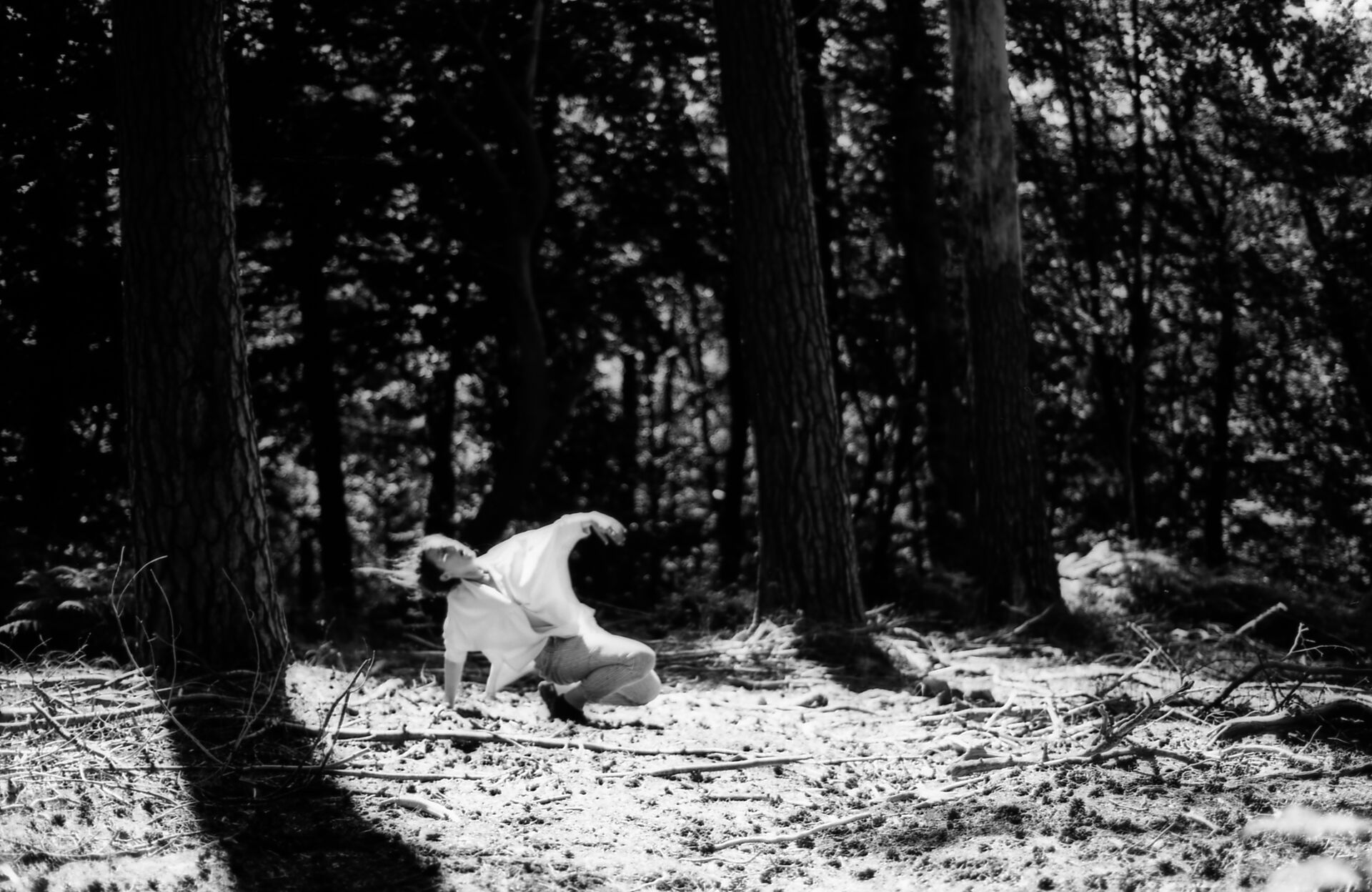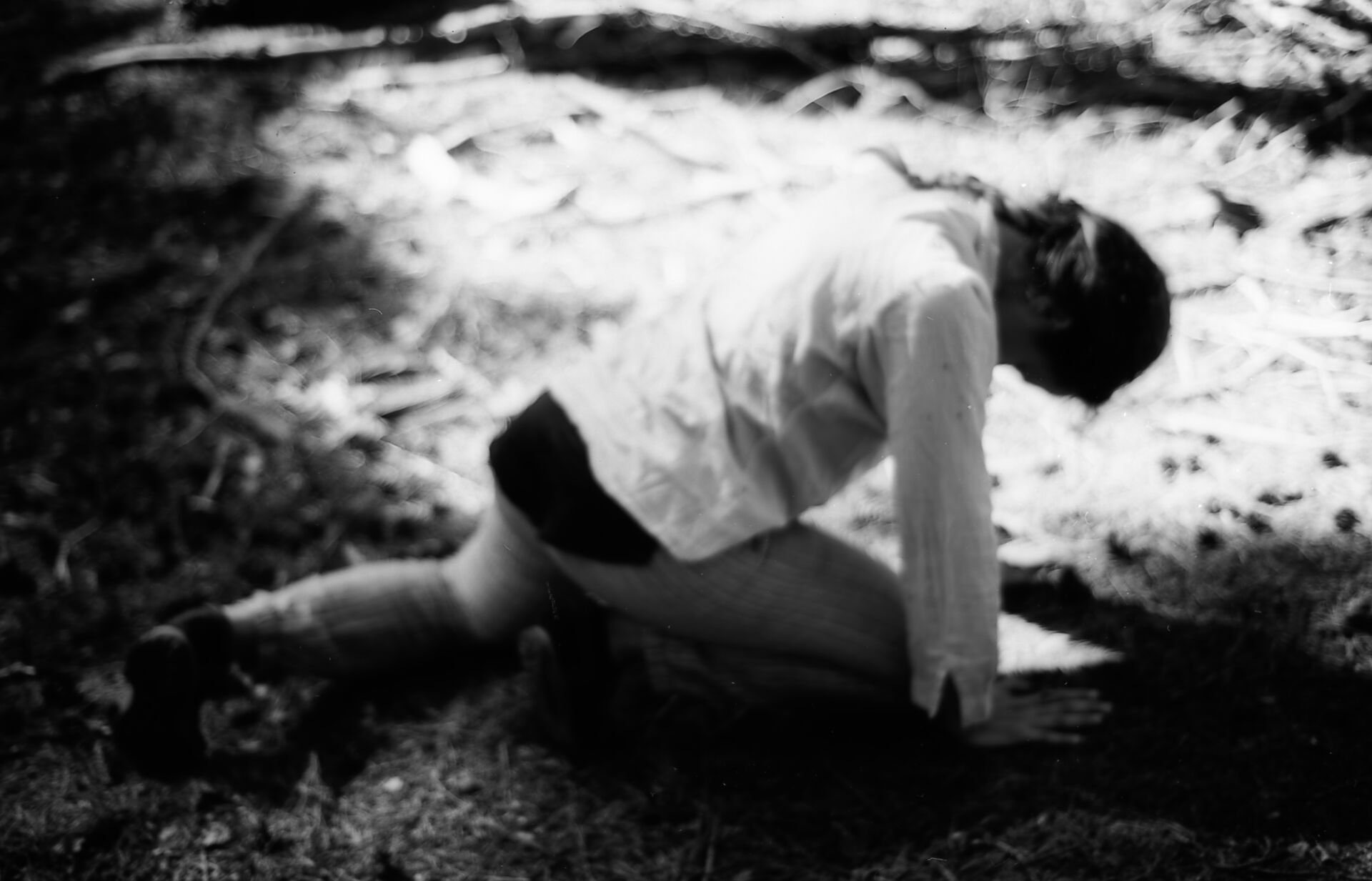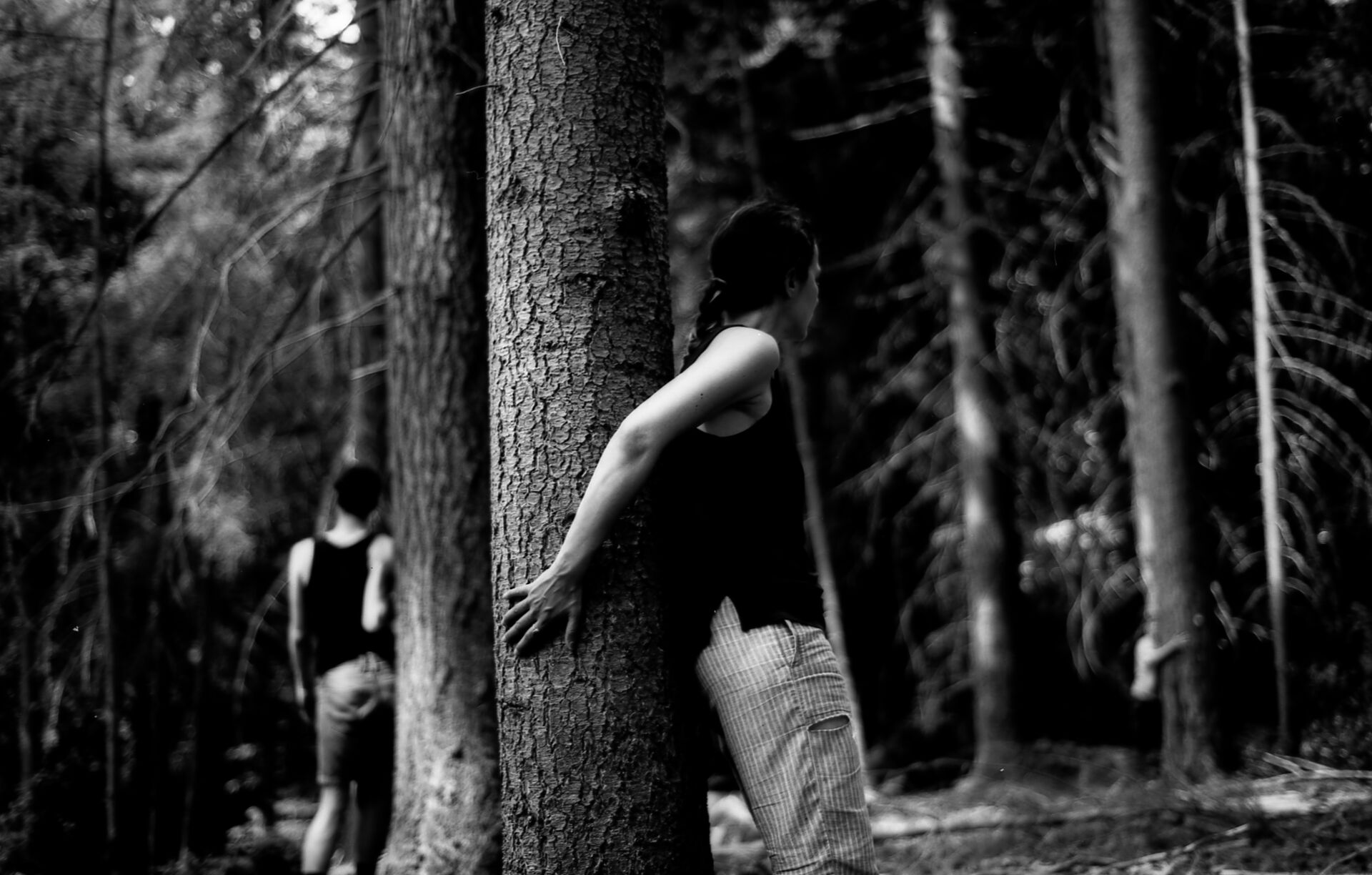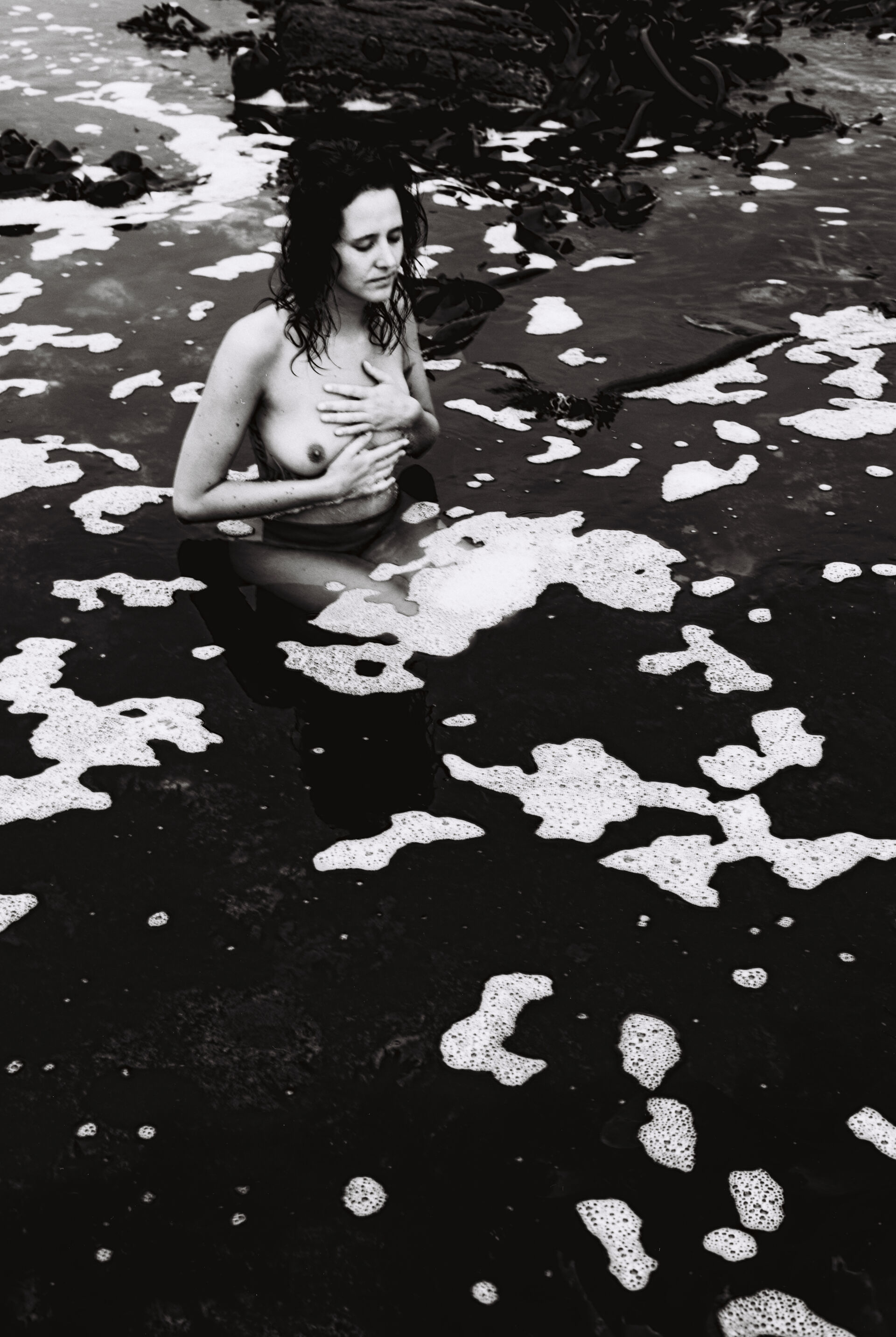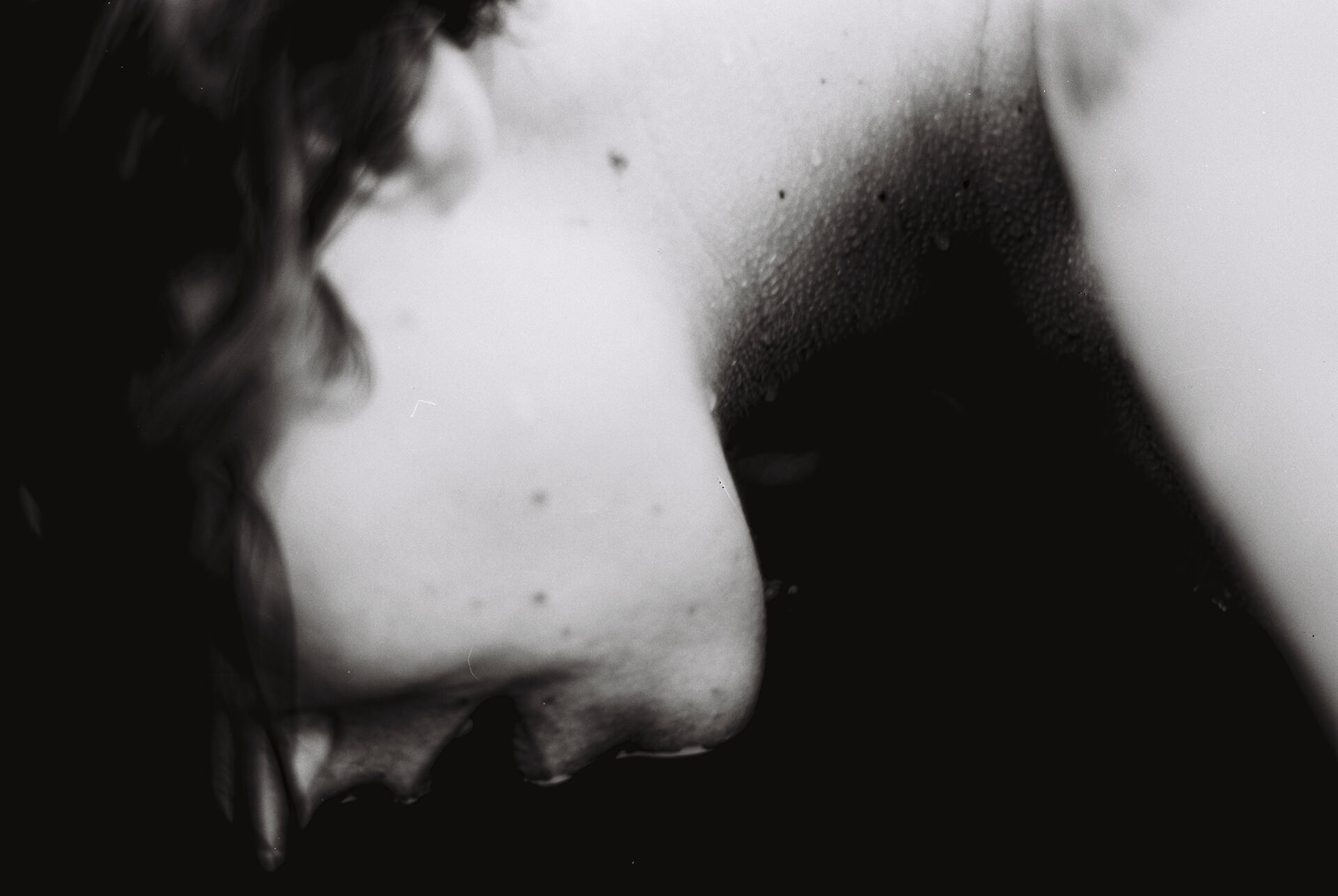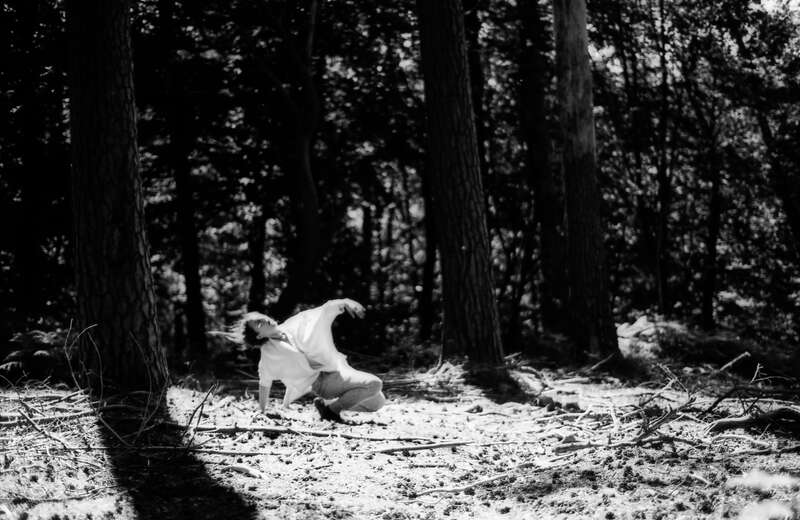
Mira Matthew, Francesca Saraullo improvising, in the aftermath of a sensitive dance practice, 2020.
A Journey Through Somatic Landscapes. Feeling, Healing … and Photography
Author's Note. My curiosity about somatic practices was born during the lockdown, faced with the necessity of being connected with my sensations, emotions, and developmental possibilities within a social tissue that was at once in a state of control and disintegration. Where could we find the freedom to relate to one another in order to counteract the isolation? The field of somatic education defines itself as the study of the consciousness of the body moving through space. It regroups different methods, techniques, and practices, some of which will be outlined in this text. I have mapped out my meetings with practitioners and dancers based in Brussels who have had a significant positive influence on my health over these last two years. This research is inseparable from my earlier studies in herbalism and phytotherapy, revealing them to be strongly complementary.
Stéphanie Verin
28 jan. 2023 • 16 min
The somatic experience
Finding each other in the forest becomes a vital practice from which experiments in movement are born. We spend time with my friends: Mira Matthew, audio-visual artist and photographer, and Francesca Saraullo, dancer/performer, choreographer, teacher, and researcher. We explore diverse movements: conscious walking, rolling and oscillating our pelvises. Francesca shares practices from her research, which in 2020 was called ‘Archaeology of Gesture’, encompassing a ten-year apprenticeship in Sensitive Dance that she undertook in Italy with Claude Coldy. Sensitive Dance, created in collaboration with osteopaths Jean Louis and Marie Dupuis in 1990, is a somatic practice that helps individuals find harmony between their body and their mind. The approach brings the body into a slowing down and a spontaneity of movement.
The influence of Authentic Movement on Sensitive Dance has become clear to me. Their origins are distant in a geographic sense, the United States and Janet Adler on one continent and Italy and Claude Coldy on the other. Nevertheless, the practices complement each other and their visions overlap: a defining element reunites them, the presence of a witness who beholds a mover, who, eyes closed, connects to their sensations, devoting themselves to a movement in resonance with their state of being, developing their own patterns of repetition. In Sensitive Dance, we refer to an accompanist and a movement explorer. In both practices, the importance of being seen or witnessed in one’s process with one’s body and emotions is primordial.
‘Self-revelation requires encounter between self and other: the revealer needs an other to be revealed.’Rabbin Arthur Green in Janet Adler’s Offering from the Conscious Body: The Discipline of Authentic Movement (Inner Traditions, 2002), 59.
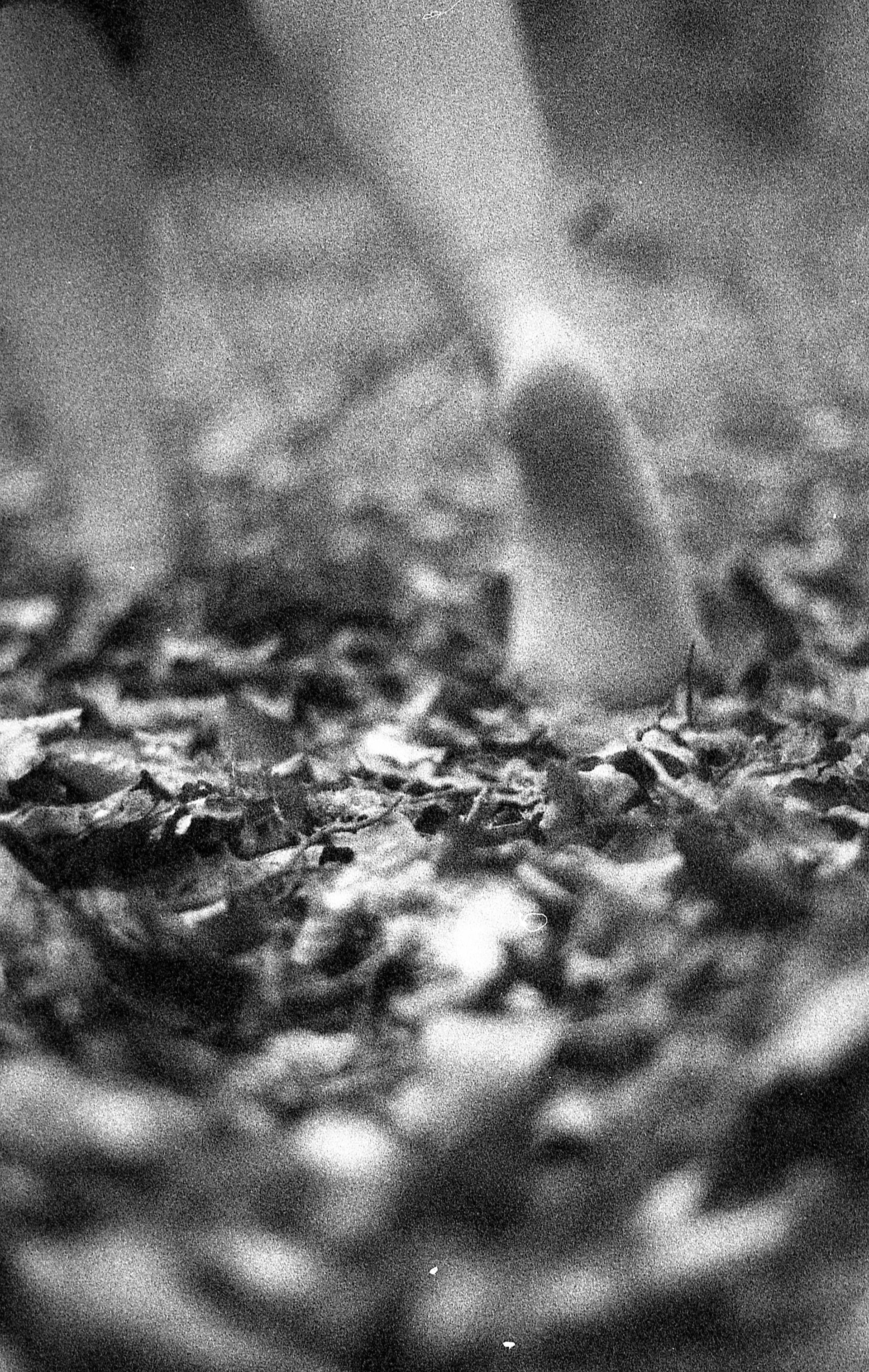
Mira Matthew, Francesca Saraullo practicing sensitive dance in the forest, 2020.
Janet Adler, in Offering from the Conscious Body: The Discipline of Authentic Movement, retraces the experiences of movers and demonstrates the importance of the relationship with the witness:
The momentum of your walking
holds the world up for me.
I count on your walking.
I count on your walking.
You stir the room for me.
You cry for me.
I need you right here right here
being what you do.
Tracking your tears
I map these tears.
I name each one.
Sorrow wells in my ribs.Janet Adler, Offering from the Conscious Body: The Discipline of Authentic Movement (Inner Traditions, 2002), 158.
My first memory of sensitive dance, in a duo with Francesca Saraullo, consists of descending to the ground with eyes closed, accompanied by her presence. She places her hand on the top my head and lets it slide like a caress, all the way down my spine to my sacrum, forming a big circle behind me. I feel her presence. All the while, I am able to dive into my sensations and enter a form of meditation. She places her hand on my forehead and asks me to allow the weight of my head to progressively drop towards the ground, allowing the unravelling of my spine and the bending of my knees. On all fours, on my hands and knees, she positions one hand between my shoulder blades, at heart level, and one upon my pelvis, at the level of my sacrum. She invites me to move freely, accompanied by the sensation of her hands upon my back, to roll my hips and my head. I recall being reminded of what felt right by her presence, and I recall warmth filling my heart area, heating me. I am also reminded of a sense of timidity at being so closely accompanied. She steps back, leaving me to enter a four-legged walk, straight ahead. I seek to sense the transfer of weight, and I walk very slowly in order to feel my pelvis. She steps back once more and opens the space, dancing whilst maintaining the connection with me. After a moment I stop, sit, and redress myself, and then I open my eyes, slowly turning towards Francesca. I do not understand exactly where I am, nor do I understand the process that I have just undertaken, but I feel an appeasement and a strong sense of not being alone, a sense of having been heard and understood, a sense that I spoke without words.
Somatic practice as a creative source
A somatic practice can create a practitioner, a healer, but it can also be part of a creative process. During Francesca’s workshops, she dives into collective healing processes. She is currently developing Corpo Pelvico, reassembling her choreographic research, her memories, her imaginings, her sensations, and her stories that come from further off, from another time – archaic. Francesca is particularly interested in the anatomical space of the pelvis – as a pillar of balance within the body, as a source of vitality, and as a centre of memory. Visualisations experienced during the dance can come from the unconscious, or from impulses given by the facilitator during a session. We observe comings and goings between three centres: the mental body, the emotional body, and the physical body. These visualisations can then be spoken, written, or drawn: the order in which one voyages between these centres is totally free – what is important is to create more fluid kinetic energy. This movement was conceptualised by Daria Halprin as a psychokinetic imagery process, working between the kinaesthetic body, the visualised images, and the lived experience.Daria Halprin is an American dancer and actress specialising in art therapy.
Francesca shares a dance memory: ‘My body was very hot. The dancer threw me in the air and I felt my body like a fish out of water, but the dancer failed to catch me and I fell with a thud on the floor. I was over two metres above the ground and I started to laugh! My body was supple. My spinal column was fine. I was unhurt.’Francesca Saraullo in conversation with the author, 15 July 2022.Francesca’s imagery here brings us back to the first forms of life on earth – the fish, as an archaic image, ancestral, brought to light within a sensorial experience.
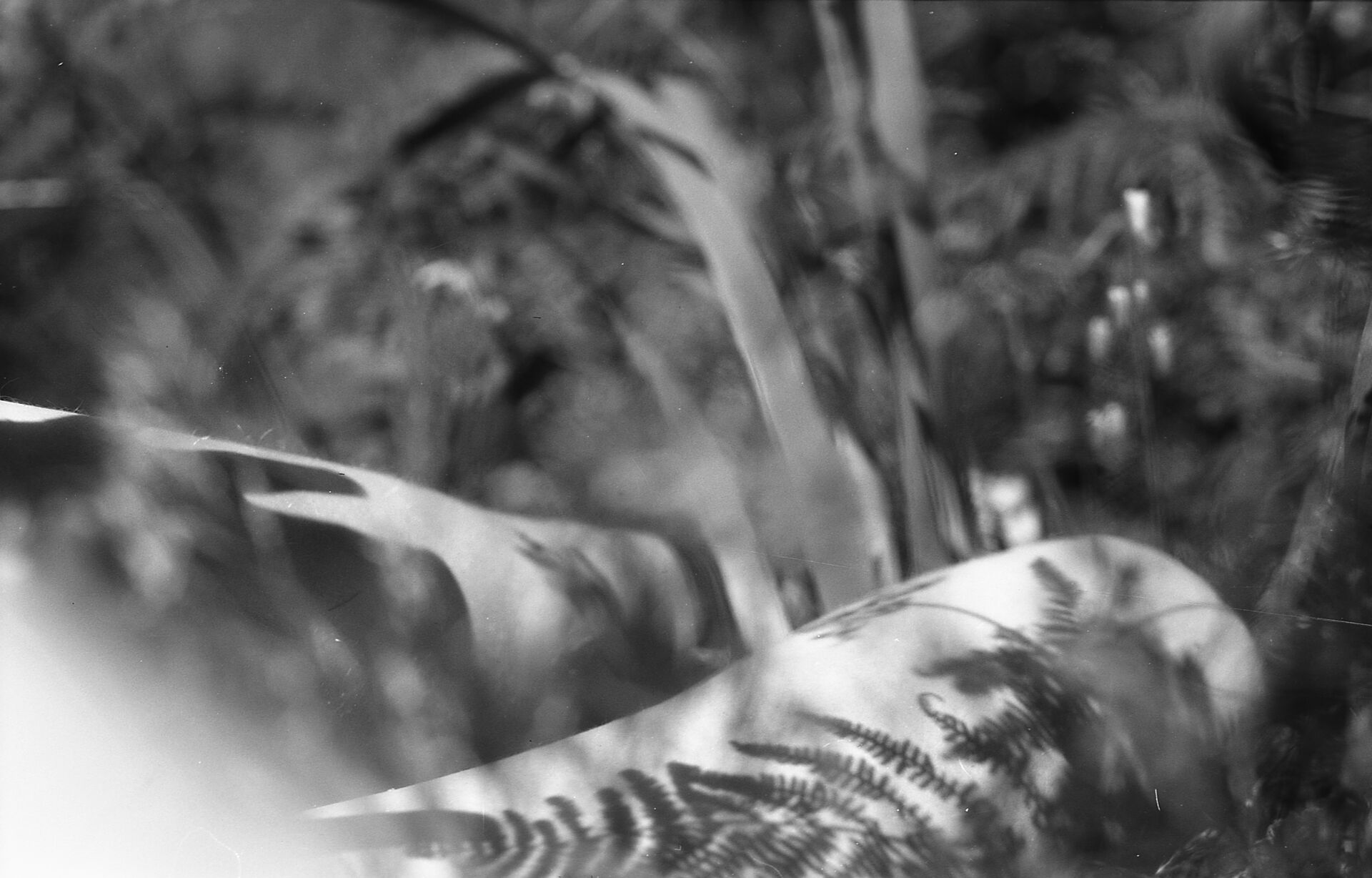
Mira Matthew, Auto-portrait during a tandava practice in South Africa, 2020.
Mira Matthew has been taking photographs since her adolescence in Cape Town, South Africa, collecting dancing images. At seventeen years old, she travels to India as a devotee of Iyengar yoga and studies different forms of Tantra. Nude, she interrogates the sensations that natural elements have on her body. She photographs Francesca Saraullo, practising Sensitive Dance, and Olivia Crow,Olivia Crow is a tantric practitioner from Worcester, living in Cape Town, South Africa.practising the tandavaTandava means dance in Sanskrit. It refers to a cosmic dance, said to be performed by Shiva, that reflects the cycles of creation and destruction.in the Atlantic Ocean – both women engaged in somatic practices immersed in an outdoor environment. Her appetite for somatic practices begins with the discovery of the Five Rhythms with Hannah Loewenthal in Cape Town, and later through the Alexander Technique with Sarah Ludi, a Swiss dancer living in Brussels. Florence Augendre also accompanies her in ‘fasciapulsodance’, a practice combining fasciapulsology, dance, and dream work. Mira tells me, ‘My perpetual dichotomy was between art and the somatic. Now, I am beginning to find pathways which render them inseparable and ethically aligned.’Mira Matthew in conversation with the author, 16 June 2022.Mira finds resolution by transposing the somatic into her creative process: the somatic trance state becomes an overarching key element in her work; by allowing her photographer’s body to enter into a certain state of consciousness, the world around her is captured in this ‘embodied’ fashion, which by extension reveals the incarnation of plants, beings, and elements. Recurring leitmotifs in her visualisations are leaves, moss, lichen, and algae.
In the somatic tradition, photographs have often been used to show how a body responds to its environment, how the posture of the body reveals the way in which certain organs function and how the body reflects natural elements in its surroundings. We can perceive interesting clichés of this kind in the book Sensing, Feeling, and Action
by Bonnie Bainbridge Cohen, with representative analogies of, for example, a tree and lungs or multiple observations of the body in movement.Bonnie Bainbridge Cohen is a dancer and researcher and the creator of the somatic method of Body-Mind Centering.The analytic lecture of photographs led me to search for another relationship between somatic imagery through Mira Matthew, who infuses her photographic practice with dance and erotic poetics.
The body Sensorial
For that I touch
That I am
Undone in this way
I may play
To leap from the grey grim sleepwalker’s sky
Into a delicious pool of colourful sensation
Mira Matthew
July 2022
The somatic, a space for relational reparation
In the practice of Awareness Through Movement (ATM), we engage in the discovery of sensations and emotions, which are conceptually differentiated in Cohen’s experimental anatomy. To sense, one would refer to the nervous system, to feel is connected to one’s emotions, a response to an experience coming from the blood. That which is to be sensed will be perceived by the nervous system, whereas on a deeper level, the feeling will be connected to older memories, as during embryonic development liquids are present before the formation of the nervous system.
Betzabel FalfanBetzabel Falfan is a Mexican actress, dancer, and Feldenkrais teacher living in Brussels.and Nikos Appelqvist DaltonNikos Appelqvist Dalton is a Danish photographer, director, and Feldenkrais teacher living in Brussels.host me at Forest Light House, a centre that opened two years ago in Brussels, dedicated to the Feldenkrais Method, which I discovered initially by participating in a workshop given by the dancer Meytal Blanaru,Meytal Blanaru an Israeli dancer, choreographer, and Feldenkrais teacher living in Brussels.who has created a body of work, Fathom High, a research and teaching between dance and Feldenkrais. Moshe Feldenkrais presented his method in Israel in the 1950s. It was created in the aftermath of a serious knee injury. He develops 20,000 movement patterns that would become means of potentiating learning processes and finding ways to heal. By practising ATM and via its functional integrations, each student discovers alternative movement possibilities with curiosity. Betzabel tells me of an individual treatment with a woman who had trouble getting up from her chair: ‘When we discovered together that she had to simply bring her feet closer in order to facilitate the transfer of weight, it was a revelation.’Betzabel Falfan in conversation with the author at Forest Lighthouse, 16 June 2022.Nikos refines his pedagogic vision: ‘In practice, we create relationships. We are never in a therapeutic framework. We ask ourselves how to ask the best questions in order for each student to learn something. Perhaps I can change my attitude; perhaps it’s my emotional attitude that is causing the problem. Every time it is a new investigation.’Nikos Appelqvist in conversation with the author at Forest Lighthouse, 16 June 2022.
Pain is the indicator of a problem, and so it is not the enemy but in fact a source of information. According to recent research, pain might be reversible and can potentially be unlearned. The healing of deep physical or psychological wounds is a fertile and active field of research, regularly enriched with new methods, in particular Pain Reprocessing Therapy (PRT), a new treatment paradigm for chronic pain out of the United States that might be taught at Forest Lighthouse in the coming years.
Within the diversity of practices and methods that exist, it is wise to choose for oneself what works during a given period. One finds this out through experimentation. I meet Ady ElzamAdy Elzam is an Israeli dancer, teacher, and Ilan Lev Method practitioner living in Brussels.during his dance workshops and take an interest in his practice, which consists of muscle releasing techniques, trance, and breath. We meet once more during a series of individual treatments that I receive from him after injuring my back and ankle in a fall during a contact improvisation practice. As a practitioner of the Ilan Lev Method, he expresses his vision that somatic practices depend more on the practitioner than on the method. The Ilan Lev Method is dynamic, acoustic, fast paced, danced, and tactile. Ilan Lev,Ilan Lev is an Israeli who studied economics, reflexology, and Feldenkrais. He is the creator of the Ilan Lev Method.a former student of Moshe Feldenkrais in Israel, insisted upon developing his own language through repetition and innovation. He never gave the same class twice. The specificity of the method is that it works with gamma waves, which are rapid – situated at 35 hertz, they reflect heightened cerebral activity. They are commonly engaged during problem solving and creative processes. In my specific case, Ady Elzam’s treatments operate as much on the emotional plane as on the physical injuries. My spinal mobility was almost entirely re-established after the first treatment, and my ankle’s stability was regained after the second. My ability to dance was no longer impeded. The work also changed my emotional reactions to certain situations that I considered dangerous, opening me to new possibilities.
Two years earlier, I discovered Feldenkrais and dance classes with Céline Van der Haegen.Céline Van Der Haegen is a Belgian dancer, teacher, and a Feldenkrais and Amanaé practitioner living in Brussels.Céline practices the Amanaé method, which uses subtle touch for the activation of cellular memories. The practice is largely focused on opening the heart and respiratory regions, which are both linked to liquid systems – liquids nourish the cells, and it is inside the cells that life exists. A practitioner will focus on places that are stagnant, by clearing traces of trauma that are memorised by the body, and they will seek ways to open energetic portals. Touch – contact – activates the cells of the lower brain, which possesses a widespread system of information; it also activates the cerebellum and the midbrain, which convoke the notions of weight and gravity.
Lived experiences are first treated on a cellular level and thus recorded in the nervous system. The brain is the last to treat the information and to bring in other elements, like emotion, sentiments, thoughts, understanding, and compassion and healing. The process of embodiment (or incarnation) allows one to connect to this first level of experience and be able to treat old memories.
I based my reflections on my own healing through somatic methods, but I also sought out testimonies from others. While discussing my research with Mila BisbrouckMila Bisbrouck is a French art student and illustrator living in Burgundy.during a contemporary dance class, she generously and spontaneously proposes to tell of her process. After multiple medical examinations, revealing a high level of cholesterol, she decides to begin a diet that gradually lays the groundwork for anorexia nervosa. Her illness goes unnoticed by those close to her. She realises that her health is in danger when her menstrual cycle ceases. She then diagnoses herself and decides to seek help. She notices a direct improvement in the state of her health when she starts to dance again, a practice that she had stopped. By observing her possible defences, her disassociations, her traumas, and her shadows, she finds a way to reintegrate them through her body. Paying attention to her emotions and intentionally directing her movements can help to resolve addictions, apathy, and frustrations. Mila describes her research, from classical ballet to hip-hop to the freedom from codes offered by contemporary dance. Her story questions aesthetic norms and the pressure that advertising and social media has on the appearance of the body, often becoming a certain authority on what it means to ‘feel good’. Her case is interesting because she doesn’t necessarily engage in somatic practices but simply uses movement and physical exercise in order to heal herself. The American thinker Richard Shusterman goes back to the first philosophical concepts that touched on the connection of mind and body, considering this connection to be a precept for self-knowledge.Richard Shusterman, Body Consciousness: A Philosophy of Mindfulness and Somaesthetics (University of Chicago Press 2019), 31.
Here, I have attempted to bring to light the practices that helped me personally, during this lockdown, to find more proximity with an enhanced collective consciousness and to maintain the health of my nervous system. Sensitive Dance, in particular, has the potential to open spaces and collective reflections, inviting the individual to be conscious of their body, which is connected to the rest of the world, and to regenerate and reveal parts of the self that have been buried. The anti-speciesismPhilosophers Richard D. Ryder and Peter Singer developed the concept ‘antispeciesism’, opposing it to speciesism – a concept defined by the same principles as racism and sexism, readapted and refined fifteen years later by the French journal Cahiers antispécistes, which defined it as a tendency to place the human race above all others and according it a higher moral consideration than certain animal species.carved into the practice enables the fusion of identifications, from human to human, from human to vegetal, from human to animal, and opens the communications between these fields. Faced with a global energy crisis, is the somatic tool a possible resource for public health as well as an entry point to a more developed environmental consciousness, from a sensorial, a metaphysical, and a political point of view?
What role could photography play in this process of awareness? Could it also be a vector for research in and of itself and a photosensitive archive of poetic bodies in action? There is a necessity to render more visible somatic practices, with their diversity and their nuances, not only for the value of their effects on the individual but also for what they could imply on a more global scale, if we were to integrate them into the education system.
Recommended reading for interested readers
- Janet Adler, Offering from the Conscious Body: The Discipline of Authentic Movement (Inner Traditions, 2002).
- Daria Halprin et al., De l’une à l’autre, composer, apprendre et partager en mouvements (Editions Contredanse, 2010).
- Bonnie Bainbridge Cohen, Sensing, Feeling and Action (Contact Editions, 1993).
- This academic journal harbors a lot of material on the relation between dance and psychotherapy: Body, Movement and Dance in Psychotherapy: An International Journal for Theory Research and Practice, collective work by Cressida Forester (Taylor and Francis Group, 2015).
- Richard Shusterman, Body Consciousness: A Philosophy of Mindfulness and Somaesthetics (University of Chicago Press 2019).
- Norman Doidge, The Brain’s Way of Healing: Stories of Remarkable Recoveries and Discoveries (Penguins Books, 2016).
Thank you to Francesca Saraullo, Tom Viaene, Esther Génicot, Ady Elzam, Mira Matthew, Nikos Appelqvist Dalton, Betzabel Falfan, Mila Bisbrouck, Céline Van der Haegen, Yota Dafniotou and Claire Destrée, without whom this essay would not have been possible.
